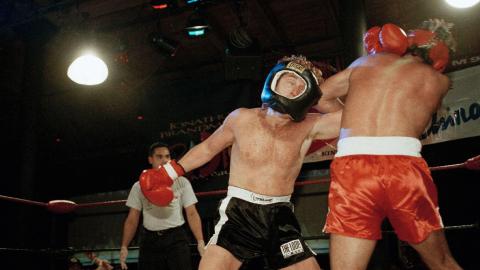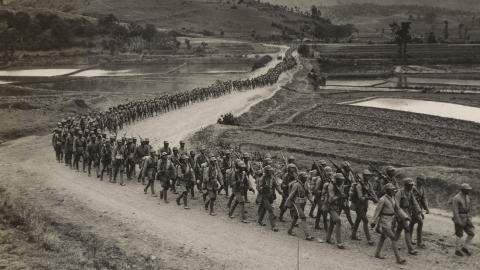Sino-Japanese War
There were about 800 Japanese present, some of whom were in sedan chairs . . . the binding of prisoners and shooting kept up until 2 o'clock in the morning.
Captain Liang Ling-fang testimony to Tokyo War Crimes Tribunal on the Nanking Massacres
In the 1930s, China was a divided country. In 1928 Chiang Kai-Shek had formed a Nationalist Government – the Kuomintang (the KMT), but his dictatorial regime was opposed by Mao Tse Tung's Communists (CCP). Civil war between the Communists and Nationalists erupted in 1930 – the period of Mao's legendary 'Long March'.
In 1931, Japan, eager for the vast natural resources to be found in China and seeing her obvious weakness, invaded and occupied Manchuria. It was turned into a nominally independent state called Manchukuo, but the Chinese Emperor who ruled it was a puppet of the Japanese. When China appealed to the League of Nations to intervene, the League published the Lytton Report which condemned Japanese aggression. The only real consequence of this was that an outraged Japanese delegation stormed out of the League of Nations, never to return.
In the 1930's the Chinese suffered continued territorial encroachment from the Japanese, using their Manchurian base. The whole north of the country was gradually taken over. The official strategy of the KMT was to secure control of China by defeating her internal enemies first (Communists and various warlords), and only then turning attention to the defence of the frontier. This meant the Japanese encountered virtually no resistance, apart from some popular uprisings by Chinese peasants which were brutally suppressed.
In 1937 skirmishing between Japanese and Chinese troops on the frontier led to what became known as the Marco Polo Bridge Incident. This fighting sparked a full-blown conflict, the Second Sino-Japanese War. Under the terms of the Sian Agreement, the Chinese Nationalists (KMT) and the CCP now agreed to fight side by side against Japan. The Communists had been encouraged to negotiate with the KMT by Stalin, who saw Japan as an increasing threat on his Far Eastern border, and began supplying arms to China. China also received aid from western democracies, where public opinion was strongly anti-Japanese. Britain, France and the US all sent aid (the latter including the famous 'Flying Tigers' fighter-pilot volunteers). Because of historic ties, China also received aid from Nazi Germany for a short period, until Hitler decided to make an alliance with Japan in 1938.
Although the Japanese quickly captured all key Chinese ports and industrial centres, including cities such as the Chinese capital Nanking and Shanghai, CCP and KMT forces continued resisting. In the brutal conflict, both sides used 'scorched earth' tactics. Massacres and atrocities were common. The most infamous came after the fall of Nanking in December 1937, when Japanese troops slaughtered an estimated 300,000 civilians and raped 80,000 women. Many thousands of Chinese were killed in the indiscriminate bombing of cities by the Japanese air force. There were also savage reprisals carried out against Chinese peasants, in retaliation for attacks by partisans who waged a guerrilla war against the invader, ambushing supply columns and attacking isolated units. Warfare of this nature led, by the war's end, to an estimated 10 to 20 million Chinese civilians deaths.
By 1940, the war descended into stalemate. The Japanese seemed unable to force victory, nor the Chinese to evict the Japanese from the territory they had conquered. But western intervention in the form of economic sanctions (most importantly oil) against Japan would transform the nature of the war. It was in response to these sanctions that Japan decided to attack America at Pearl Harbor, and so initiate World War II in the Far East.
Did you know?
The second Sino-Japanese War made up more than 50 per cent of the casualties in the Pacific War if the 1937-1941 period is taken into account.
















